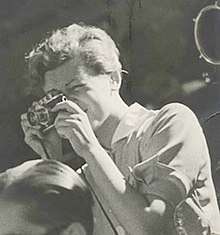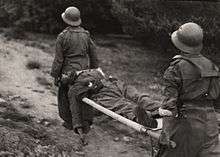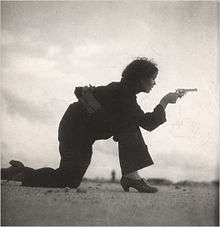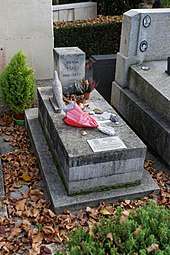Gerda Taro
Gerta Pohorylle (1 August 1910 – 26 July 1937), known professionally as Gerda Taro, was a German Jewish war photographer active during the Spanish Civil War. She is regarded as the first woman photojournalist to have died while covering the frontline in a war.
Gerda Taro | |
|---|---|
 Taro in Spain, July 1937
Leica camera and 5cm Summar lens | |
| Born | Gerta Pohorylle 1 August 1910[1] |
| Died | 26 July 1937 (aged 26) |
| Resting place | Cimetière du Père-Lachaise, Paris, France |
| Partner(s) | Robert Capa (1935–1937) |
| Parents |
|
Taro was the companion and professional partner of photographer Robert Capa. The name "Robert Capa" was originally an alias that Taro and Capa (born Endre Friedmann) shared, an invention meant to mitigate the increasing political intolerance in Europe and to attract the lucrative American market. A significant amount of what is credited as Robert Capa's early work was actually made by Taro[3].
Early life
Pohorylle was born on 1 August 1910 in Stuttgart, Germany to Gisela Boral and Heinrich Pohorylle, a middle-class Jewish family that had recently emigrated from East Galicia. There she attended the Queen Charlotte High School (de) and later a business college, spending a year at a Lausanne boarding school in between.[4][5][6]
In 1929, the family moved to Leipzig, just prior to the rise of Nazi Germany. Taro opposed the National Socialist German Workers Party (the name of the Nazi party in Germany) and became interested in Leftist politics. In 1933, following the Nazi party's coming to power, she was arrested and detained for distributing propaganda against the National Socialists. Eventually, the entire Pohorylle household was forced to leave Germany toward different destinations. Taro, age 23, headed for Paris, while her parents attempted to reach mandatory Palestine (also known as Eretz Yisrael at that time by Jews seeking to reestablish a safe homeland). Her brothers went to England. She would not see her family again.[6][7][8]
Career
Taro's career was brief, but with great impact on photojournalism, especially in war.
Establishing the Robert Capa alias
When Pohorylle moved to Paris in 1934 to escape the anti-Semitism of Hitler's Germany she met the photojournalist Endre Friedmann,[9][10] a Hungarian Jew, learned photography and became his personal assistant. They fell in love.[11] Pohorylle began to work for Alliance Photo as a picture editor.[5][7][8][12]
In 1936, Pohorylle received her first photojournalist credential. Then, she and Friedmann devised a plan where Friedmann claimed to be the agent of photographer Robert Capa, a name they invented. Both took news photographs and sold them as the work of the non-existent American photographer Robert Capa;[7] this was a convenient name overcoming the increasing political intolerance prevailing in Europe and attractive for the lucrative American market.[5] Capa was derived from Friedmann's Budapest street nickname "Cápa" which means "Shark" in Hungarian. The secret did not last long, but Friedmann kept the more commercial name "Capa" for his own name, while Pohorylle adopted the professional name of "Gerda Taro" after the Japanese artist Tarō Okamoto and Swedish actress Greta Garbo.[5][7][8][1] The two worked together to cover the events surrounding the coming-to-power of the Popular Front in 1930s France.
Coverage of the Spanish Civil War


When the Spanish Civil War broke out in 1936, Taro travelled to Barcelona, Spain, to cover the events with Capa and David "Chim" Seymour. Taro acquired the nickname of La pequeña rubia ("The little blonde"). They covered the war together in northeastern Aragon and in the southern Córdoba province. Always together under the common and using the bogus signature of Robert Capa, they succeeded in publishing through important publications (the Swiss Zürcher Illustrierte, the French Vu). Their early war photographs are distinguishable since Taro used a Rollei camera which rendered squared photographs while Capa produced rectangular pictures using a Contax camera or a Leica camera. However, for some time in 1937 they each produced similar 35 mm pictures under the label of Capa&Taro.[5][7][8][13]
Subsequently, Taro attained some independence. She refused Capa's marriage proposal. Also, she became publicly related to the circle of anti-fascist European and intellectuals (such as Ernest Hemingway and George Orwell) who crusaded particularly for the Spanish Republic. fr:Ce Soir, a communist newspaper of France, signed her for publishing Taro's works only. Then, she began to commercialise her production under the Photo Taro label. Regards, Life, Illustrated London News and Volks-Illustrierte (the exile edition of Arbeiter-Illustrierte-Zeitung) were amongst the publications that used her work.[5][7]
Reporting the Valencia bombing alone, Taro obtained the photographs which are her most celebrated. Also, in July 1937, Taro's photographs were in demand by the international press when, alone, she was covering the Brunete region near Madrid for Ce Soir. Although the Nationalist propaganda claimed that the region was under its control, the Republican forces had in fact forced that faction out. Taro's photographs were the only testimony of the actual situation.[5][7][8]
Death

During her coverage of the Republican army retreat at the Battle of Brunete, Taro hopped onto the runningboard of General Walter's car that was carrying wounded soldiers.[14] A Republican tank crashed into its side and Taro suffered critical wounds, dying the following day, 26 July 1937.[5][14]
The circumstances of Taro's death have been questioned by British journalist Robin Stummer, writing in the New Statesman magazine.[15] Stummer cited Willy Brandt, later Chancellor of West Germany, and a friend of Taro's during the Spanish Civil War, saying that she had been the victim of the Stalinist purge of Communists and Socialists in Spain not aligned to Moscow. However, Stummer provided no other evidence for this claim.
In an interview with the Spanish daily El País, a nephew of a Republican soldier at the Battle of Brunete explained that she had died in an accident. According to the eye-witness account, she had been run over by a reversing tank and she died from her wounds in El Goloso English hospital a few hours later. The tank driver did not realize what he had done.[16]
Due to her political commitment, Taro had become a respected anti-fascist figure. On 1 August 1937, on what would have been her 27th birthday, the French Communist Party gave her a grand funeral in Paris, drawing tens of thousands of people on to the streets,[17] buried her at Père Lachaise Cemetery, and commissioned Alberto Giacometti to create a monument for her grave.[18]
In early 2018, a photograph purported to be an image of Taro on her deathbed in the English war hospital was released by the son of Hungarian Dr. Kiszely who treated her.[19]
Legacy
On 26 September 2007, the International Center of Photography opened the first major U.S. exhibition of Taro's photographs.[20]
In October 2008, the City of Stuttgart named a square at the intersection of Hohenheimer, Dannecker and Alexander Strasse after Taro. the Gerda-Taro-Platz.[21] The square was redesigned in 2014, with an inauguration ceremony on 18 November, to include 9 metal steles, each with one letter of her name cut out, visible from a distance.[22][23]
In the summer of 2016 an open-air display of Taro's Spanish Civil War photographs was part of the f/stop photography festival in Leipzig. When the festival ended, it was decided the display, partly paid for by crowdfunding, would become permanent. Shortly after, on 4 August, the display of Taro's work was destroyed by smearing it with black paint. With a crowdfunding project to restore the work ongoing, the destroyed work remains in place. It is suspected the destruction is motivated by anti-refugee or anti-semitic sentiments.[24]
The novel Waiting for Robert Capa, by Susana Fortes (2011 – English translation by Adriana V. López), is a fictionalized account of the life of Taro and Capa.
The documentary film, The Mexican Suitcase (2011), tells the story of a suitcase of 4,500 lost negatives taken by Taro, Capa and David Seymour during the Spanish Civil War.[13] The suitcase, and the negatives, are currently housed at the International Center of Photography in New York City.[25] The stage play Shooting With Light, produced by theater company Idle Motion, is based on this film. In sorting through the works of this collection, many photographs once attributed to Capa were found to be Taro's, thus allowing a greater understanding of her contribution to photojournalism.[1] Describing one difference in her style as compared to that of Capa, curator Kristen Lubben said "Her pictures are much more posed, using strong camera angles. Capa was much more into movement."[1]
The British indie rock band alt-J's song "Taro" is about her role as a war photographer during the Spanish Civil War as well as her relationship to Capa. The song describes the graphic details of Capa's death ("A violent wrench grips mass / Rips light, tears limbs like rags") and imagines Taro's complementary emotions.[26][27]
In 2017 the City Council of Madrid decided to name a street in the city Calle Gerda Taro (Gerda Taro Street), a street running from Avenida de la Victoria to Calle Durango; it is located northwest from the city center along the route A6.[28][29].
The city of Paris did the same in 2019 with the new Rue Gerda Taro, in the 13th arrondissement, by unanimous vote of the political groups of the Council of Paris.
In 2018, the city of Leipzig named a new gymnasium for 1,200 students after Taro; it is near the display of her photographs on permanent exhibition.[30]
She was highlighted on Google's Doodle on August 1, 2018.[31]
In 2017 she was the subject of the novel The Girl with the Leica, by Helena Janeczek.[32]
Publications
- Capa, Robert (1938), Death in the Making, New York: Covici Friede,
Photographs by Taro and Capa
References
Notes
- Lee, Felicia R. (22 September 2007). "A Wartime Photographer in Her Own Light". The New York Times. Archived from the original on 1 August 2018. Retrieved 21 February 2017.
- Schaber, Irme; Whelan, Richard; Lubben, Kristen (2007). Gerda Taro: From the Collection of the International Center of Photography. Steidl/ICP. p. 11. ISBN 978-3-86521-532-1.
- "Gerda Taro - The Girl with a Leica". DailyArt Magazine.
- Schaber, Irme; Whelan, Richard; Lubben, Kristen (2007). Gerda Taro: From the Collection of the International Center of Photography. Steidl/ICP. pp. 12, 162. ISBN 978-3-86521-532-1.
- Steinman, Ron (October 2007). "Capa and Taro: Together at Last". The Digital Journalist.
- Whelan, Richard (1994). Robert Capa: A Biography. University of Nebraska Press. ISBN 0-8032-9760-2.
- Diu, Nisha Lilia (9 December 2007). "Gerda Taro: the blonde of brunete". The Telegraph. Retrieved 1 August 2018.
- "Exhibition: Gerda Taro" (PDF). International Center of Photography. Archived from the original (PDF) on 16 November 2007. Retrieved 9 May 2008.
- O'Hagan, Sean (12 May 2012). "Robert Capa and Gerda Taro: love in a time of war". The Guardian. Retrieved 2 August 2018.
- "Shot in the thick of battle". Evening Standard. Retrieved 2 August 2018.
- Dyer, Geoff (17 October 2008). "Geoff Dyer on the changing face of war photography". The Guardian. Retrieved 2 August 2018.
- Schaber, Irme; Lewandowski, Philippe (3 December 2007). "Gerda Taro – A revolutionary photographer in the Spain's war". Egodesign.
- Kennedy, Randy (27 January 2008). "Robert Capa's lost negatives make a dramatic reappearance". The New York Times. Retrieved 1 August 2018.
- Aronson, Marc; Budhos, Marina (2017). Eyes of the World Robert Capa, Gerda Taro, and the Invention of Modern Photojournalism. Macmillan Publishing Group, LLC. ISBN 9780805098358.
- Stummer, Robin (9 October 2008). "Accidental heroine". New Statesman.
- Antón, Jacinto (12 July 2009). "¡Te has cargado a la francesa!" [You knocked off the French woman!]. El País (in Spanish). Retrieved 1 August 2018.
- "Close-up: Gerda Taro". The Independent. Retrieved 2 August 2018.
- Whelan, Richard (2001). Robert Capa, the definitive collection. Phaidon. p. 8. ISBN 978-0-7148-4449-7.
- Tremlett, Giles (19 January 2018). "Gerda Taro: 'deathbed photo' of war photographer discovered". The Guardian. Retrieved 1 August 2018.
- Ree, Felicia R. (22 September 2007). "A Wartime Photographer in Her Own Light". New York Times. p. B7. Retrieved 9 July 2019.
- Lessat, Jürgen (18 August 2012). "Hohenheimer Straße: Mehr Aufmerksamkeit für Gerda Taro" [Hohenheimer Strasse: More attention for Gerda Taro]. Stuttgarter Nachrichten (in German). Retrieved 27 June 2019.
- Eyerle, Nina (21 November 2014). "Eröffnung: OB Kuhn fordert mehr Gedenkstätten" [Opening: OB Kuhn demands more memorial sites]. Stuttgarter Zeitung (in German). Retrieved 27 June 2019.
- "Gerda-Taro-Platz nach Umgestaltung eingeweiht" [Gerda Taro Square inaugurated after redesign]. City of Stuttgart (in German). 18 November 2014. Retrieved 27 June 2019.
- Russezki, Jan (19 August 2016). "Aufstand gegen die Schwarzmaler" [Art scandal in Leipzig: rebellion against the black painters]. Frankfurter Allgemeine Zeitung (in German).
- "The Mexican Suitcase: Rediscovered Spanish Civil War Negatives by Capa, Chim, and Taro". International Center of Photography. Retrieved 10 September 2015.
- Martin, Gary Winchester (18 January 2014). "Alt-J Writes Entire Song About Two Photographers Dying In War". Fstoppers: Editorial Photography. Retrieved 1 August 2018.
- "Gerda Taro: Republican militiawoman training on the beach outside Barcelona, photograph, 1936". Arts in Exile (virtual exhibition). Federal Republic of Germany. Retrieved 2 August 2018.
- "Cambio de nombre de determinadas calles, plazas y travesías de la ciudad de Madrid" [Name change for some streets, squares and crossings in the city of Madrid] (PDF) (in Spanish). Madrid City Council. 4 May 2017. Retrieved 9 May 2019.
- Gómez, Virginia (26 April 2018). "El Ayuntamiento de Madrid comienza a cambiar las placas de las calles franquistas" [The Council of Madrid starts changing the plates in Francoist streets]. El Mundo (in Spanish).
- "Schule an der Telemannstraße heißt jetzt Gerda-Taro-Schule" [School on Telemannstrasse is now called Gerda Taro School] (in German). City of Leipzig. 28 June 2018. Retrieved 1 August 2018.
- Musil, Steven (31 July 2018). "Google Doodle honors pioneering female war photographer Gerda Taro". CNET. Retrieved 1 August 2018.
- Mackay, Jamie (23 November 2019). "The Girl With the Leica by Helena Janeczek review – a revolutionary life in pictures". The Guardian. ISSN 0261-3077. Retrieved 20 February 2020.
Further reading
- Schaber, Irme (1994), Gerta Taro: Fotoreporterin im spanischen Bürgerkrieg: eine Biografie [Gerda Taro: photojournalist in the Spanish Civil War: a biography] (in German), Marburg: Jonas, ISBN 978-3-89445-175-2
- Olmeda, Fernando (2007), Gerda Taro, fotógrafa de guerra: el periodismo como testigo de la historia [Gerda Taro, war photographer: journalism as a witness to history] (in Spanish), Barcelona: Editorial Debate, ISBN 978-84-8306-702-4
- Schaber, Irme; Lubben, Kristen; Whelan, Richard (2007), Gerta Taro, International Center of Photography and Steidl, ISBN 978-3865215321
- Maspero, François (2008), Out of the Shadows: A Life of Gerda Taro, Souvenir, ISBN 978-0285638259
- Arroyo, Lorna (2011). Documentalismo técnico en la Guerra Civil española. Inicios del fotoperiodismo moderno en relación a la obra de Gerda Taro [Technical documentation in the Spanish Civil War. Beginnings of modern photojournalism in relation to the work of Gerda Taro] (PhD) (in Spanish). Castellón: Universidad Jaime I.
- Rogoyska, Jane (2013), Gerda Taro – Inventing Robert Capa, London: Jonathan Cape, ISBN 978-0224097130
External links
| Wikimedia Commons has media related to Gerda Taro. |
- "International Center of Photography Holds First Major Exhibition of Taro's Work", The New York Times, 22 September 2007.
- "Exhibition – Gerda Taro – This is War exhibition at the Barbican", Magnum Photos, 2008.